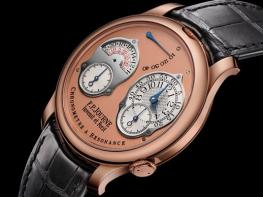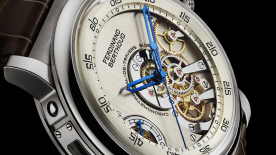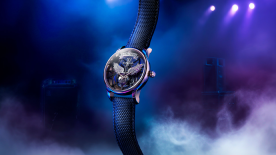As he wants to ensure his watches have faces like no other, François-Paul Journe decided twelve years ago to found Les Cadraniers de Genève.
WORLDTEMPUS - 15 January 2013Miguel Seabra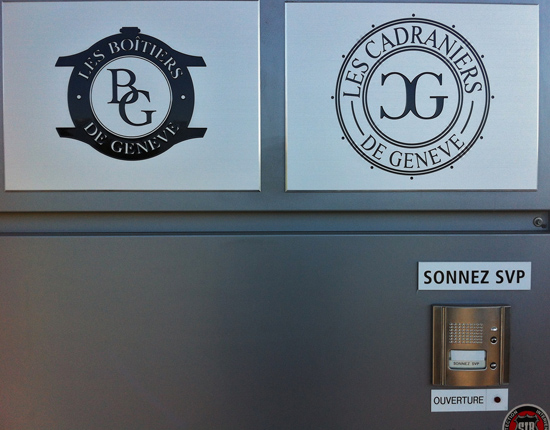 “I had Cédric Johner and Harry Winston as associates when we founded the company back in 2000. Since then, I have bought their shares of the business and now have Vacheron Constantin as a partner,” Journe says. Owning a company specialized in dial fabrication was a logical move that has been followed by many other significant players in the industry at various levels, from TAG Heuer (ArteCad) to Bulgari (Cadrans Design) to the Richemont Group itself (Stern Créations). Why logical? Journe is pragmatic: “A dial is the watch's face; if we have it made by a manufacturer that does dials for everybody, our watches will look like everyone else's – or everyone else will have watches looking like ours.” He is also poetic: “The dial is the face of a watch and its soul. If you don't own your dial, you don't own your soul.”New premisesFormerly located in Grand Lancy, Les Cadraniers de Genève now shares a brand-new building with its sister company Les Boîtiers de Genève (manufacturers of cases, also owned by F.P. Journe) in Meyrin, a neighborhood on the outskirts of Geneva populated by watch-related firms. The 2,600 m2 production site, inaugurated last September in the presence of Journe, Vacheron Constantin's CEO Juan Carlos Torres and a few local dignitaries, enables the preservation of manufacturing quality as well as progression of the brand's strategy in the long term. Right now, the yearly production is an estimated 11,000 dials and the staff comprises 22 employees. Those numbers are naturally expected to go up.
“I had Cédric Johner and Harry Winston as associates when we founded the company back in 2000. Since then, I have bought their shares of the business and now have Vacheron Constantin as a partner,” Journe says. Owning a company specialized in dial fabrication was a logical move that has been followed by many other significant players in the industry at various levels, from TAG Heuer (ArteCad) to Bulgari (Cadrans Design) to the Richemont Group itself (Stern Créations). Why logical? Journe is pragmatic: “A dial is the watch's face; if we have it made by a manufacturer that does dials for everybody, our watches will look like everyone else's – or everyone else will have watches looking like ours.” He is also poetic: “The dial is the face of a watch and its soul. If you don't own your dial, you don't own your soul.”New premisesFormerly located in Grand Lancy, Les Cadraniers de Genève now shares a brand-new building with its sister company Les Boîtiers de Genève (manufacturers of cases, also owned by F.P. Journe) in Meyrin, a neighborhood on the outskirts of Geneva populated by watch-related firms. The 2,600 m2 production site, inaugurated last September in the presence of Journe, Vacheron Constantin's CEO Juan Carlos Torres and a few local dignitaries, enables the preservation of manufacturing quality as well as progression of the brand's strategy in the long term. Right now, the yearly production is an estimated 11,000 dials and the staff comprises 22 employees. Those numbers are naturally expected to go up.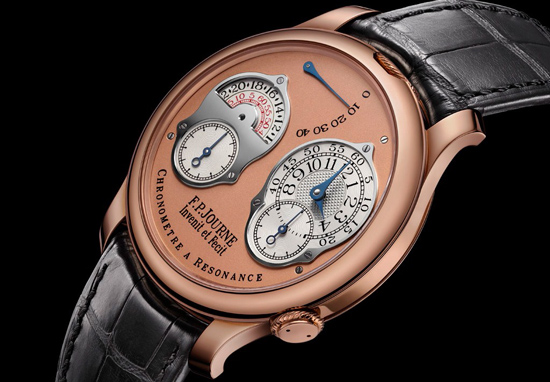 The priority resides in providing dials for the facility's owners, but there are a few top-notch brands that also have specific dials made there. Ironically, being a manufacturer of high-quality dials – a specialty steeped in tradition – the managers at Les Cadraniers (manufacturing director Tony Billet and administrative director Stéphane Cornioley) will surprise you by disclosing that the big advantage of working for Journe, one of the fiercest guardians of traditional watchmaking these days, is that “François-Paul is not too attached to tradition regarding dial fabrication, showing an open mind regarding new solutions.”
The priority resides in providing dials for the facility's owners, but there are a few top-notch brands that also have specific dials made there. Ironically, being a manufacturer of high-quality dials – a specialty steeped in tradition – the managers at Les Cadraniers (manufacturing director Tony Billet and administrative director Stéphane Cornioley) will surprise you by disclosing that the big advantage of working for Journe, one of the fiercest guardians of traditional watchmaking these days, is that “François-Paul is not too attached to tradition regarding dial fabrication, showing an open mind regarding new solutions.” 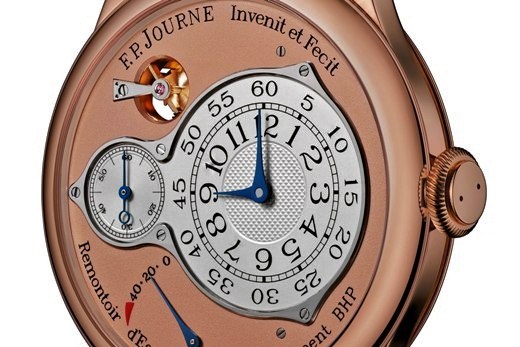 There are some 20 dial manufacturers in Switzerland capable of satisfying the various demands of their clients, but not all of them at the highest level. Particularly in an era boasting structured dials embellished with different layers and comprising several parts. Many specialized companies still feature a traditional way of fabrication, with manufacturing secrets passed from one generation to the other. At Les Cadraniers, Billet refutes any kind of heritage that would handcuff an “out of the box” solution. “We can say that we are different from the traditional dial manufacturers. Since Stéphane and I came from other areas, we did not have any preconceived ideas regarding the product. Dials have been made using the same process for 30, 40 or 50 years, while manufacturing procedures have significantly changed in the past decade and new materials were brought into the mix. Nowadays, the demanding levels are completely different and the quality required is higher than ever.” A most difficult dial The ultimate goal is to have a dial beautiful, sophisticated, exuding harmony and at the same time allowing perfect legibility. Additionally, it needs to show lots of character. From the inception of his brand, Journe has equipped most of his timepieces with emblematic dials made of 18-karat gold galvanized to a color of choice (for example deep matte black for the exclusive F.P. Journe boutique models), featuring off-centered subsidiary dials crafted in silver and decorated with screws and a guilloché pattern that became synonymous with the Invenit et Fecit signature. The nuances between the main dial and silvered subdials are accentuated by lighting conditions.
There are some 20 dial manufacturers in Switzerland capable of satisfying the various demands of their clients, but not all of them at the highest level. Particularly in an era boasting structured dials embellished with different layers and comprising several parts. Many specialized companies still feature a traditional way of fabrication, with manufacturing secrets passed from one generation to the other. At Les Cadraniers, Billet refutes any kind of heritage that would handcuff an “out of the box” solution. “We can say that we are different from the traditional dial manufacturers. Since Stéphane and I came from other areas, we did not have any preconceived ideas regarding the product. Dials have been made using the same process for 30, 40 or 50 years, while manufacturing procedures have significantly changed in the past decade and new materials were brought into the mix. Nowadays, the demanding levels are completely different and the quality required is higher than ever.” A most difficult dial The ultimate goal is to have a dial beautiful, sophisticated, exuding harmony and at the same time allowing perfect legibility. Additionally, it needs to show lots of character. From the inception of his brand, Journe has equipped most of his timepieces with emblematic dials made of 18-karat gold galvanized to a color of choice (for example deep matte black for the exclusive F.P. Journe boutique models), featuring off-centered subsidiary dials crafted in silver and decorated with screws and a guilloché pattern that became synonymous with the Invenit et Fecit signature. The nuances between the main dial and silvered subdials are accentuated by lighting conditions.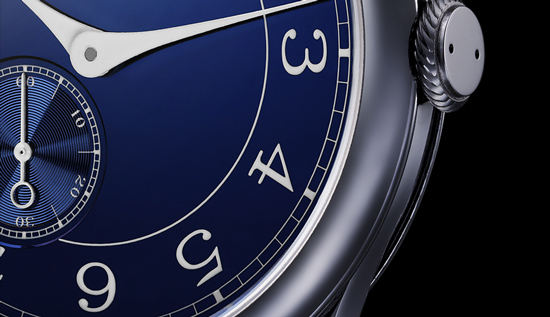 Oddly enough, among the various dials stamped with the F.P. Journe logo, the one surprisingly and unanimously considered by Journe, Billet and Cornioley as the most difficult to execute is an atypical dial within the collection: the bluish chrome dial of the Chronomètre Bleu. Its manufacture requires mini openings so delicate that any false step will ruin everything. It actually looks simple, but, as Journe puts it, “It's a highly demanding simplicity.” The smallest polishing mistake would be fatal and only 30 per cent of the production will pass the quality testing. Several layers are required to acquire the exact blue tone on a plaque thinner than a sheet of paper.
Oddly enough, among the various dials stamped with the F.P. Journe logo, the one surprisingly and unanimously considered by Journe, Billet and Cornioley as the most difficult to execute is an atypical dial within the collection: the bluish chrome dial of the Chronomètre Bleu. Its manufacture requires mini openings so delicate that any false step will ruin everything. It actually looks simple, but, as Journe puts it, “It's a highly demanding simplicity.” The smallest polishing mistake would be fatal and only 30 per cent of the production will pass the quality testing. Several layers are required to acquire the exact blue tone on a plaque thinner than a sheet of paper. The manufacture of a dial goes through several stages, depending on its complexity and the materials used. Some require over 200 operations and more than twelve crafts, from the initial cutting of the plate up to the application of indeces and numerals. Just like in any activity that requires minutia, handmade dials demand a high level of artisanship and patience to create a perfect finish. After all, no one will want to perform any plastic surgery to the face of time...
The manufacture of a dial goes through several stages, depending on its complexity and the materials used. Some require over 200 operations and more than twelve crafts, from the initial cutting of the plate up to the application of indeces and numerals. Just like in any activity that requires minutia, handmade dials demand a high level of artisanship and patience to create a perfect finish. After all, no one will want to perform any plastic surgery to the face of time...
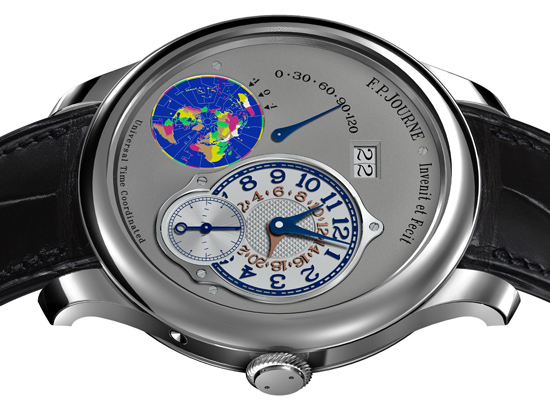
The F.P. Journe Octa UTC with a colored earth divided into time zones.
© F.P. Journe
 “I had Cédric Johner and Harry Winston as associates when we founded the company back in 2000. Since then, I have bought their shares of the business and now have Vacheron Constantin as a partner,” Journe says. Owning a company specialized in dial fabrication was a logical move that has been followed by many other significant players in the industry at various levels, from TAG Heuer (ArteCad) to Bulgari (Cadrans Design) to the Richemont Group itself (Stern Créations). Why logical? Journe is pragmatic: “A dial is the watch's face; if we have it made by a manufacturer that does dials for everybody, our watches will look like everyone else's – or everyone else will have watches looking like ours.” He is also poetic: “The dial is the face of a watch and its soul. If you don't own your dial, you don't own your soul.”New premisesFormerly located in Grand Lancy, Les Cadraniers de Genève now shares a brand-new building with its sister company Les Boîtiers de Genève (manufacturers of cases, also owned by F.P. Journe) in Meyrin, a neighborhood on the outskirts of Geneva populated by watch-related firms. The 2,600 m2 production site, inaugurated last September in the presence of Journe, Vacheron Constantin's CEO Juan Carlos Torres and a few local dignitaries, enables the preservation of manufacturing quality as well as progression of the brand's strategy in the long term. Right now, the yearly production is an estimated 11,000 dials and the staff comprises 22 employees. Those numbers are naturally expected to go up.
“I had Cédric Johner and Harry Winston as associates when we founded the company back in 2000. Since then, I have bought their shares of the business and now have Vacheron Constantin as a partner,” Journe says. Owning a company specialized in dial fabrication was a logical move that has been followed by many other significant players in the industry at various levels, from TAG Heuer (ArteCad) to Bulgari (Cadrans Design) to the Richemont Group itself (Stern Créations). Why logical? Journe is pragmatic: “A dial is the watch's face; if we have it made by a manufacturer that does dials for everybody, our watches will look like everyone else's – or everyone else will have watches looking like ours.” He is also poetic: “The dial is the face of a watch and its soul. If you don't own your dial, you don't own your soul.”New premisesFormerly located in Grand Lancy, Les Cadraniers de Genève now shares a brand-new building with its sister company Les Boîtiers de Genève (manufacturers of cases, also owned by F.P. Journe) in Meyrin, a neighborhood on the outskirts of Geneva populated by watch-related firms. The 2,600 m2 production site, inaugurated last September in the presence of Journe, Vacheron Constantin's CEO Juan Carlos Torres and a few local dignitaries, enables the preservation of manufacturing quality as well as progression of the brand's strategy in the long term. Right now, the yearly production is an estimated 11,000 dials and the staff comprises 22 employees. Those numbers are naturally expected to go up. The priority resides in providing dials for the facility's owners, but there are a few top-notch brands that also have specific dials made there. Ironically, being a manufacturer of high-quality dials – a specialty steeped in tradition – the managers at Les Cadraniers (manufacturing director Tony Billet and administrative director Stéphane Cornioley) will surprise you by disclosing that the big advantage of working for Journe, one of the fiercest guardians of traditional watchmaking these days, is that “François-Paul is not too attached to tradition regarding dial fabrication, showing an open mind regarding new solutions.”
The priority resides in providing dials for the facility's owners, but there are a few top-notch brands that also have specific dials made there. Ironically, being a manufacturer of high-quality dials – a specialty steeped in tradition – the managers at Les Cadraniers (manufacturing director Tony Billet and administrative director Stéphane Cornioley) will surprise you by disclosing that the big advantage of working for Journe, one of the fiercest guardians of traditional watchmaking these days, is that “François-Paul is not too attached to tradition regarding dial fabrication, showing an open mind regarding new solutions.”  There are some 20 dial manufacturers in Switzerland capable of satisfying the various demands of their clients, but not all of them at the highest level. Particularly in an era boasting structured dials embellished with different layers and comprising several parts. Many specialized companies still feature a traditional way of fabrication, with manufacturing secrets passed from one generation to the other. At Les Cadraniers, Billet refutes any kind of heritage that would handcuff an “out of the box” solution. “We can say that we are different from the traditional dial manufacturers. Since Stéphane and I came from other areas, we did not have any preconceived ideas regarding the product. Dials have been made using the same process for 30, 40 or 50 years, while manufacturing procedures have significantly changed in the past decade and new materials were brought into the mix. Nowadays, the demanding levels are completely different and the quality required is higher than ever.” A most difficult dial The ultimate goal is to have a dial beautiful, sophisticated, exuding harmony and at the same time allowing perfect legibility. Additionally, it needs to show lots of character. From the inception of his brand, Journe has equipped most of his timepieces with emblematic dials made of 18-karat gold galvanized to a color of choice (for example deep matte black for the exclusive F.P. Journe boutique models), featuring off-centered subsidiary dials crafted in silver and decorated with screws and a guilloché pattern that became synonymous with the Invenit et Fecit signature. The nuances between the main dial and silvered subdials are accentuated by lighting conditions.
There are some 20 dial manufacturers in Switzerland capable of satisfying the various demands of their clients, but not all of them at the highest level. Particularly in an era boasting structured dials embellished with different layers and comprising several parts. Many specialized companies still feature a traditional way of fabrication, with manufacturing secrets passed from one generation to the other. At Les Cadraniers, Billet refutes any kind of heritage that would handcuff an “out of the box” solution. “We can say that we are different from the traditional dial manufacturers. Since Stéphane and I came from other areas, we did not have any preconceived ideas regarding the product. Dials have been made using the same process for 30, 40 or 50 years, while manufacturing procedures have significantly changed in the past decade and new materials were brought into the mix. Nowadays, the demanding levels are completely different and the quality required is higher than ever.” A most difficult dial The ultimate goal is to have a dial beautiful, sophisticated, exuding harmony and at the same time allowing perfect legibility. Additionally, it needs to show lots of character. From the inception of his brand, Journe has equipped most of his timepieces with emblematic dials made of 18-karat gold galvanized to a color of choice (for example deep matte black for the exclusive F.P. Journe boutique models), featuring off-centered subsidiary dials crafted in silver and decorated with screws and a guilloché pattern that became synonymous with the Invenit et Fecit signature. The nuances between the main dial and silvered subdials are accentuated by lighting conditions. Oddly enough, among the various dials stamped with the F.P. Journe logo, the one surprisingly and unanimously considered by Journe, Billet and Cornioley as the most difficult to execute is an atypical dial within the collection: the bluish chrome dial of the Chronomètre Bleu. Its manufacture requires mini openings so delicate that any false step will ruin everything. It actually looks simple, but, as Journe puts it, “It's a highly demanding simplicity.” The smallest polishing mistake would be fatal and only 30 per cent of the production will pass the quality testing. Several layers are required to acquire the exact blue tone on a plaque thinner than a sheet of paper.
Oddly enough, among the various dials stamped with the F.P. Journe logo, the one surprisingly and unanimously considered by Journe, Billet and Cornioley as the most difficult to execute is an atypical dial within the collection: the bluish chrome dial of the Chronomètre Bleu. Its manufacture requires mini openings so delicate that any false step will ruin everything. It actually looks simple, but, as Journe puts it, “It's a highly demanding simplicity.” The smallest polishing mistake would be fatal and only 30 per cent of the production will pass the quality testing. Several layers are required to acquire the exact blue tone on a plaque thinner than a sheet of paper. The manufacture of a dial goes through several stages, depending on its complexity and the materials used. Some require over 200 operations and more than twelve crafts, from the initial cutting of the plate up to the application of indeces and numerals. Just like in any activity that requires minutia, handmade dials demand a high level of artisanship and patience to create a perfect finish. After all, no one will want to perform any plastic surgery to the face of time...
The manufacture of a dial goes through several stages, depending on its complexity and the materials used. Some require over 200 operations and more than twelve crafts, from the initial cutting of the plate up to the application of indeces and numerals. Just like in any activity that requires minutia, handmade dials demand a high level of artisanship and patience to create a perfect finish. After all, no one will want to perform any plastic surgery to the face of time...
Featured brand
